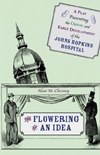How Stanley Mazaroff—who has been a Baltimore employment lawyer, a 62-year-old Johns Hopkins freshman, and Blue Jay lacrosse legend Jerry Schnydman’s Little League baseball coach—became the author of an art history book is a complicated story. That’s appropriate given the complex and conflicted relationship of the title characters in Mazaroff’s tight, focused work, Henry Walters and Bernard Berenson: Collector & Connoisseur (Johns Hopkins University Press, 2010). The book explores the peculiar background of the Walters Art Museum’s acquisition of Italian Renaissance paintings.
After the death of his beloved father, William, in 1894, Henry Walters became caught up in the collecting of Italian Renaissance artwork, an obsession that afflicted many American captains of industry. With one sweeping $1 million purchase in 1902 ($25,700,000 in 2010 dollars), Walters acquired most of the highly touted collection of Don Marcello Massarenti, a priest and member of the papal court, netting approximately 930 paintings. About 520 of them were by Italian artists, and many were dubiously attributed to giants like Caravaggio, Leonardo da Vinci, Michelangelo, and Titian. By this single purchase Walters hoped to become one of the nation’s preeminent collectors of Renaissance painting—and to acquire a cornerstone collection on which to build a museum to honor his late father.
Walters’ purchase put him on the radar of Berenson, one of the world’s preeminent Italian art connoisseurs and dealers. To ingratiate himself with Walters, Berenson offered in 1909 to prepare an illustrated catalog of his Italian paintings. Walters accepted the offer. But in 1914, when Berenson finally came to Baltimore to examine Walters’ trove, he was scathing about what he regarded as the true creators of the works. Of 293 Italian paintings from Massarenti then on display in Walters’ gallery, only 30 retained their original attributions.
By 1917, Walters had severed his relationship with Berenson and washed the latter’s name from museum records. Five years later, Walters was finished with the art collecting business and began getting rid of many of the formerly valuable paintings. From the Massarenti trove, he retained only the handful that were actually works by masters. In 1975, a new catalog noted that while Walters’ collection turned out not to be a compendium of master works, it was one of the nation’s best surveys of Italian Renaissance painting.
After Mazaroff decided to retire early from active law practice in 2000, he enrolled at Johns Hopkins as an art history freshman. After two years of attending class with 17- and 18-year-olds (and a mini-mester in Florence) as a “special student,” Mazaroff soon upgraded to graduate level coursework and met Steven Campbell, chair of the Department of Art History. Mazaroff produced a research project for Campbell about the Massarenti collection, and with Campbell’s encouragement ended up expanding his research into what became a book manuscript.
At last, a field guide to one of the most perplexing, confusing, and irrational creatures on Earth: the human adolescent. The Teen Years Explained: A Guide to Healthy Adolescent Development (Johns Hopkins University Press, 2010) by Clea McNeely and Jayne Blanchard of the Bloomberg School of Public Health, acknowledges the realities of trying to explain smart decision making to teenagers. (Short version: It’s really, really hard.) But the book offers good strategies that can at least give kids something to think about before they engage in the risky behavior they’re not quite ready to leave behind.
Finally, if you’ve always wanted to learn of the genesis of Johns Hopkins Hospital but preferred the tale to be told in the form of a play, you’re in luck: The Flowering of an Idea, by the late dean of the Johns Hopkins Medical School Alan M. Chesney, is once again available, in softcover on demand from Johns Hopkins University Press. Chesney’s one-act play (based on Helen Hopkins Thom’s 1929 book Johns Hopkins: A Silhouette), written in 1939 for the 50th anniversary of the hospital’s opening, imagines conversations among the heavies from the hospital’s creation: Hopkins, Daniel Coit Gilman, George Peabody, John Garrett, state and local politicians, merchants, and others.



